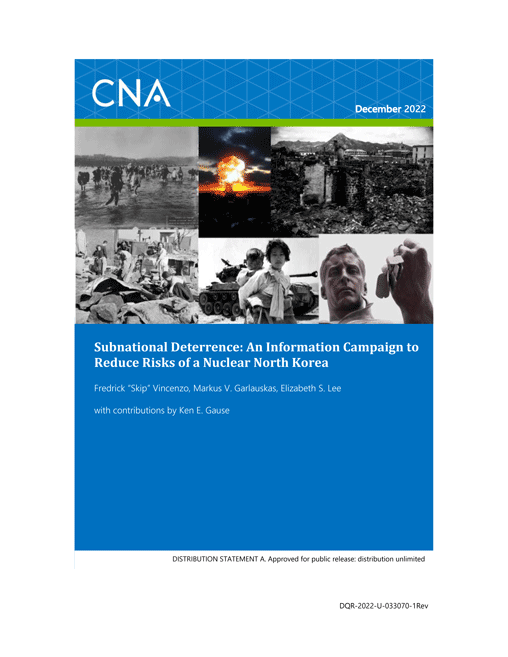This report was developed in response to a request from Commander, Naval Forces Korea for a quick-response effort to inform planning components for the Korean theater of operations (KTO) on challenging changes in the threat environment and to explore non-kinetic approaches to help overcome those challenges. This report assesses the likely effects of ongoing rapid changes in the threat environment on deterrence and the ability of the combined maritime and joint forces to successfully accomplish their wartime missions. It then introduces an alternative, non-kinetic approach termed subregime deterrence (referred to as subnational deterrence in the previous edition of this report), which the United States‒Republic of Korea (US-ROK) alliance (Alliance) could employ to enhance deterrence and ensure a less catastrophic outcome if a conflict were to occur.
As the threat from North Korea evolves, the challenges increase in magnitude, creating significant risk of a military conflict and of escalation within such a conflict. If deterrence fails to prevent a nuclear-armed North Korea from aggressive coercion, the Alliance could be forced into a war that, even if successfully won, is likely to have catastrophic costs. We suggest that subregime deterrence, enabled through a campaign of information and influence, could mitigate some of this risk by deterring a critical mass of key personnel beneath the supreme leader, Kim Jong Un, as well as audiences in the general population from enabling and supporting points of escalation. Based on previous independent work of the authors, CNA hypothesizes that an information campaign, properly supported with resources and a consistent overarching policy, could set the conditions for a subregime deterrence approach that supports the US national defense policy goal of integrated deterrence and makes a meaningful difference in the costs and risks of a crisis or conflict in the KTO.
Preliminary findings:
- The most dramatic change ongoing in the KTO threat environment is the increasing credibility of North Korea’s capability to strike targets in the continental US with nuclear weapons, combined with its apparent steps and rhetoric toward a tactical nuclear capability.
- Subregime deterrence enabled by an information campaign may induce meaningful changes in attitudes and behaviors if a crisis or conflict should occur. Major potential operational risk mitigations include reducing the violence, destruction, and duration of combat; mitigating the factors most likely to bring about significant humanitarian challenges; and lessening the resistance of military and civilian personnel in North Korea in the period after major fighting ceases.
- The contours of a sophisticated information campaign in North Korea include messaging that challenges regime narratives, validates internal doubts, and reduces fear of the outside world.
- The credibility of messaging in the information campaign is a key component in ensuring that the desired operational effects are achieved into the future. The lack of consistent overarching policy regarding information dissemination efforts in North Korea is a current obstruction to this pursuit.
- Timing matters. Information shaping should start pre-crisis. Clear, validated theater military requirements are needed to enable information-shaping efforts aimed at achieving subregime deterrence.
Recommendations have been redacted from the publicly released version of this report.
Download reportDISTRIBUTION STATEMENT A. Approved for public release: distribution unlimited.
This work was performed under Federal Government Contract No. N00014-22-D-7001.
Details
- Pages: 52
- Document Number: DQR-2022-U-033070-1Rev
- Publication Date: 12/31/2022
